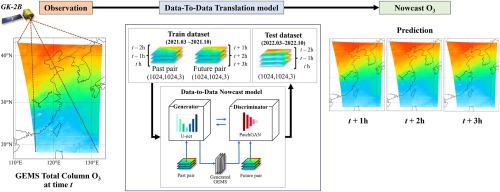当前位置:
X-MOL 学术
›
Atmos. Pollut. Res.
›
论文详情
Our official English website, www.x-mol.net, welcomes your feedback! (Note: you will need to create a separate account there.)
Enhancing ozone nowcasting over East Asia using a data-to-data translation approach with observations from a geostationary environment monitoring spectrometer
Atmospheric Pollution Research ( IF 4.5 ) Pub Date : 2024-01-20 , DOI: 10.1016/j.apr.2024.102054 Seong-Taek Oh , Jeong-Eun Park , Jaehoon Jeong , Sungwook Hong
Atmospheric Pollution Research ( IF 4.5 ) Pub Date : 2024-01-20 , DOI: 10.1016/j.apr.2024.102054 Seong-Taek Oh , Jeong-Eun Park , Jaehoon Jeong , Sungwook Hong

|
The degradation of air quality caused by excessive anthropogenic ozone (O) concentrations negatively affects ecosystems and the atmosphere. To monitor this issue, the Geostationary Environment Monitoring Spectrometer (GEMS) aboard the Geostationary Korea Multi-Purpose Satellite (GK)-2B provides ozone products over Asia-centered circular regions based on the ozone algorithm derived from representative polar-orbit atmospheric environmental satellites. In this study, we developed a few-hour GEMS O nowcasting model using data-to-data (D2D) translation with a conditional generative adversarial network. This model is based on hourly GEMS O time-series products and can be used to predict ozone concentrations. The D2D model underwent training and testing employing paired input and output datasets of GEMS O, with data collected from March 22, 2020, to June 21, 2020, and from March 22, 2021, to June 18, 2021, respectively. The resulting D2D ozone nowcasting model was used to determine ozone concentrations in time zones where GEMS O products were unavailable. Test results of the D2D model demonstrated excellent statistical scores, including a bias of 2.162 Dobson Units (DU, where 1 DU corresponds to 2.687 × 10 molecules/cm), root-mean-square error (RMSE) of 5.606 DU, a correlation coefficient (CC) of 0.994 for 1-h prediction, a bias of 1.421 DU, RMSE of 5.903 DU, and CC of 0.992 for 2-h prediction, and a bias of 1.169 DU, RMSE of 6.797 DU, and CC of 0.988 for 3-h prediction. Despite the dataset pairing and number limitations, the D2D prediction model accurately forecasted GEMS O within 3 h in East Asia.
中文翻译:

利用对地静止环境监测光谱仪的观测数据到数据转换方法,加强东亚臭氧临近预报
人为臭氧 (O) 浓度过高导致空气质量下降,对生态系统和大气产生负面影响。为了监测这一问题,韩国对地静止多用途卫星(GK)-2B上的对地静止环境监测光谱仪(GEMS)根据代表性极轨大气环境卫星得出的臭氧算法,提供以亚洲为中心的圆形区域的臭氧产品。在这项研究中,我们使用数据到数据 (D2D) 转换和条件生成对抗网络开发了一个几个小时的 GEMS O 临近预报模型。该模型基于每小时的 GEMS O 时间序列产品,可用于预测臭氧浓度。 D2D模型使用GEMS O的成对输入和输出数据集进行训练和测试,数据分别收集于2020年3月22日至2020年6月21日和2021年3月22日至2021年6月18日。由此产生的 D2D 臭氧临近预报模型用于确定无法获得 GEMS O 产品的时区的臭氧浓度。 D2D模型的测试结果显示出出色的统计分数,包括2.162 Dobson Units(DU,其中1 DU对应2.687×10分子/cm)的偏差,5.606 DU的均方根误差(RMSE),相关系数1 小时预测的 (CC) 为 0.994,2 小时预测的偏差为 1.421 DU,RMSE 为 5.903 DU,CC 为 0.992,3 小时预测的偏差为 1.169 DU,RMSE 为 6.797 DU,CC 为 0.988 -h 预测。尽管数据集配对和数量有限,D2D预测模型在东亚地区3小时内准确预测了GEMS O。
更新日期:2024-01-20
中文翻译:

利用对地静止环境监测光谱仪的观测数据到数据转换方法,加强东亚臭氧临近预报
人为臭氧 (O) 浓度过高导致空气质量下降,对生态系统和大气产生负面影响。为了监测这一问题,韩国对地静止多用途卫星(GK)-2B上的对地静止环境监测光谱仪(GEMS)根据代表性极轨大气环境卫星得出的臭氧算法,提供以亚洲为中心的圆形区域的臭氧产品。在这项研究中,我们使用数据到数据 (D2D) 转换和条件生成对抗网络开发了一个几个小时的 GEMS O 临近预报模型。该模型基于每小时的 GEMS O 时间序列产品,可用于预测臭氧浓度。 D2D模型使用GEMS O的成对输入和输出数据集进行训练和测试,数据分别收集于2020年3月22日至2020年6月21日和2021年3月22日至2021年6月18日。由此产生的 D2D 臭氧临近预报模型用于确定无法获得 GEMS O 产品的时区的臭氧浓度。 D2D模型的测试结果显示出出色的统计分数,包括2.162 Dobson Units(DU,其中1 DU对应2.687×10分子/cm)的偏差,5.606 DU的均方根误差(RMSE),相关系数1 小时预测的 (CC) 为 0.994,2 小时预测的偏差为 1.421 DU,RMSE 为 5.903 DU,CC 为 0.992,3 小时预测的偏差为 1.169 DU,RMSE 为 6.797 DU,CC 为 0.988 -h 预测。尽管数据集配对和数量有限,D2D预测模型在东亚地区3小时内准确预测了GEMS O。



























 京公网安备 11010802027423号
京公网安备 11010802027423号